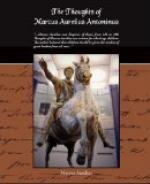There is no doubt that the Emperor’s Reflections—or his Meditations, as they are generally named—is a genuine work. In the first book he speaks of himself, his family, and his teachers; and in other books he mentions himself. Suidas (v.[Greek: Markos]) notices a work of Antoninus in twelve books, which he names the “conduct of his own life;” and he cites the book under several words in his Dictionary, giving the emperor’s name, but not the title of the work. There are also passages cited by Suidas from Antoninus without mention of the emperor’s name. The true title of the work is unknown. Xylander, who published the first edition of this book (Zuerich, 1558, 8vo, with a Latin version), used a manuscript which contained the twelve books, but it is not known where the manuscript is now. The only other complete manuscript which is known to exist is in the Vatican library, but it has no title and no inscriptions of the several books: the eleventh only has the inscription, [Greek: Markou autokratoros] marked with an asterisk. The other Vatican manuscripts and the three Florentine contain only excerpts from the emperor’s book. All the titles of the excerpts nearly agree with that which Xylander prefixed to his edition, [Greek: Markou Antoninou Autokratoros ton eis heauton biblia ib.] This title has been used by all subsequent editors. We cannot tell whether Antoninus divided his work into books or somebody else did it. If the inscriptions at the end of the first and second books are genuine, he may have made the division himself.
It is plain that the emperor wrote down his thoughts or reflections as the occasions arose; and since they were intended for his own use, it is no improbable conjecture that he left a complete copy behind him written with his own hand; for it is not likely that so diligent a man would use the labor of a transcriber for such a purpose, and expose his most secret thoughts to any other eye. He may have also intended the book for his son Commodus, who however had no taste for his father’s philosophy. Some careful hand preserved the precious volume; and a work by Antoninus is mentioned by other late writers besides Suidas.
Many critics have labored on the text of Antoninus. The most complete edition is that by Thomas Gataker, 1652, 4to. The second edition of Gataker was superintended by George Stanhope, 1697, 4to. There is also an edition of 1704. Gataker made and suggested many good corrections, and he also made a new Latin version, which is not a very good specimen of Latin, but it generally expresses the sense of the original, and often better than some of the more recent translations. He added in the margin opposite to each paragraph references to the other parallel passages; and he wrote a commentary, one of the most complete that has been written on any ancient author. This commentary contains the editor’s exposition of the more difficult passages, and quotations from all the Greek and Roman writers for the illustration




